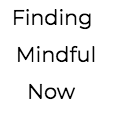
Moment of Mind
Body Awareness
In mindfulness we’re using our attention as a tool to notice our moment to moment lived experience and then letting go of the judge-y mind when it pulls us into fear of the future and worrying about the past. One of the most basic ways to bring our attention back to the present is to take several deep breaths. This is because when our attention is fully with the chatty, worrying, analyzing, judging mind it’s usually not in the present moment experience any longer. Breathing puts your attention into your body and it nudges the vagus nerve to support you in reducing anxiety.
What often happens when we skip this is that instead of feeling worried, and observing it, worry becomes our identity (this is also why naming how we feel can be so helpful – because you are not the emotion “worried”, you are feeling worried). When we are identified with our emotional states – when we become anger rather than feeling anger for example – it can be challenging to pause before we act that anger out. We want to manage our actions, not our emotions.
When we practice using attention to discover when we’re out of our present moment experience, we learn how to develop a more supportive relationship with our changing thinking, feeling, and sensing states. And sometimes this increased awareness is also what leads us to take action in unsupportive life circumstances.
Several of you wrote asking for things you can share with your kids. So today’s mind moment is the idea of a “belly breath” and it includes a fun video featuring DJ Common, Elmo and some of the Sesame Street crew. In this activity I invite you to breathe deeply into your belly, putting your hands on it as the air goes in and goes out, noticing whatever emotions are there and being with them while you keep breathing. I invite you to try this with yourself, or children, when you’re feeling okay. The more you practice in that state, the easier it will be to stay with it when chatty mind kicks up a gear. You are aiming to change your relationship to these emotional states – by becoming a friend, a mentor, or a loving relative to them. This chatty mind can’t help but be insecure because it’s made of changing, shifting, thought and our society currently doesn’t teach us the stability and wisdom within our brain-body system.
Important caveat: mindfulness is NOT about controlling the mind or body. Please do not use this video, or any mindfulness practice with children – or yourself – as a form of punishment or an attempt to control feelings or thoughts. It is 100% a myth that to be mindful you have to control your thoughts and feelings. That is impossible because your mind is generating new thought-feels constantly, all day long. It is the brain-body’s job to do this. It’s how it helps you survive and thrive. In my opinion when mindfulness is used this way it is a form of aggression and disconnection. Understanding supports connection.
Identifying how you feel and being aware of it, is the opposite of ignoring, side-stepping or covering up that feeling. Understanding how you feel can help you determine if you need to set a boundary, communicate, or take action. Mindfulness, for me, is about understanding how your mind and body is aiming to support you – even when someone else labels it as a “problem.” As a person who has learned the wisdom of having “generalized anxiety disorder” (which I now understand is a highly sensitive brain-body that developed to keep me safe in ongoing traumatic circumstances) I promise you that there are many ways your brain body supports you all the time, even when it doesn’t look that way.
Love For Your Inner Science Nerd
Greening Lots for Well Being and Reduced Crime
Finding Mindful Now leads mindfulness walks in public parks because of research indicating that time in thriving outdoor environments can support people’s stress recovery and well being. It’s also a way we can reconnect to the life that is around us and is part of us. This month’s research is focused on findings from a well-designed study in Philadelphia published last year focused on supporting community wellness through greenspace.
In this randomized, controlled trial, 541 vacant lots throughout Philadelphia were randomly assigned to one of three study treatments: a greening intervention, a trash clean-up intervention, or a control group with no intervention. An “intervention” is research-speak for when people go in and change something based on a prediction that the change will result in specific outcomes.
Researchers hired the Pennsylvania Horticultural Society LandCare program to plant new grass and trees, install short fences and sometimes grade the land, clean up trash, and maintain the lots for the “greening” intervention. The trash clean-up involved removing trash, limited grass mowing where possible, and regular monthly maintenance without the fencing or trees or land grading. The control group of lots didn’t experience any changes. This was to compare what happened for people in those areas to what happened for people in the other areas.
In terms of mental well being, the researchers found “that people living within a quarter of a mile radius of greened lots had a 41.5 percent decrease in feelings of depression compared to those who lived near the lots that had not been cleaned. Those living near green lots also experienced a nearly 63 percent decrease in self-reported poor mental health compared to those living near lots that received no intervention. Results were most pronounced when looking only at neighborhoods below the poverty line, with feelings of depression among residents who lived near green lots decreasing significantly — by more than 68 percent” (see summary here, Science Daily 2018, and original study here).
Some of the reported well-being may be related to reductions in gun assaults, burglaries, and overall crime that went down – and didn’t appear to move to nearby neighborhoods based on city-wide data. As a reporter writes in this summary, “the biggest decrease was seen in the rate of shootings in neighborhoods where the median income was below the poverty line. When compared to the areas surrounding untreated lots, gun assaults dropped by 17.4 percent near lots that received the full makeover and by 29.1 percent near lots that got any kind of greening — either the full treatment or basic clearing and mowing” (Avril, T., Feb 26, 2018, The Philadelphia Inquirer).”
Researchers lived near some of the lots during the study, attending community meetings, and documenting changes in drug and gun-related activity. From their listening to neighbors and observations, they learned that once a lot was cleared residents felt safer, were more willing to be outside, and felt more confident to shoo drug activity away. They also discovered that drug dealers were not storing guns and drugs in the open lots, they were usually in cars or apartments nearby. See second original publication on these findings here.
Another benefit of the way the researchers structured the changes is that the LandCare program includes an emphasis on local hiring. They hired local landscapers, most of them owned by people of color, or non-profits who hired residents living in the neighborhood, to maintain the lots. I am interested to see if the researchers will do any follow up studies to see if the changes contributed to displacement or if it was in a threshold of “just green enough” to support community health while preventing economic development pushing people with low incomes out. The ‘just green enough’ strategy requires local planners and residents to design green space projects that are explicitly shaped by community concerns, needs, and desires instead of only urban design or ecological conservation – without considering social justice (Wolch et al 2014). Until we change how our economic policies are structured (which currently supports wealth accumulation to the few) we have to consider how actions like these can impact those who already bear the largest burdens from racial and economic inequities.
If you live in the Portland, Metro area there is a bond measure coming up next week on the November ballot, you can learn more here – I invite you to look into it further (I am voting yes) and if you have the voting privilege, please use it. Ballots are due Nov 5, last day to mail them in safely is the day after tomorrow, Thursday, Oct 31. I’m not a resident of Washington County, and if I were I’d vote for Nafisa Fai.
From the Bookshelf: Search Inside Yourself by Chade-Meng Tan
I regularly seek out books on mindfulness written from a secular (non-religious) perspective. This book, written by the creator of a mindfulness program used at Google, Inc. (so the audience is primarily engineers) is worth the read.
The Yah’s: he first half of the book focuses on activities you can do to build your own practice. The author shares a system, similar to one I use, for structuring your own practice and many different exercises. The second half of the book helps the reader transfer understanding of oneself into understanding each other through things like intentional listening, mindful emails (breath and re-read, consider how this may land for the listener and what you’re wanting to convey, breath again before sending), and trust building in teams. All of it is useful.
The Meh’s: I couldn’t relate to some of the self-deprecating and often male-centered humor in the book, which is probably more about me than the author. The other challenge I have is common across most books on mindfulness. I find people’s description of “emotional management” to be misleading. For years I interpreted myself as flawed, or broken, because I couldn’t “control” my feeling states. I thought something was wrong with me that I feel anxious in a lot of social settings. This is until I learned how our brain-body generates emotions and thoughts on demand, based on prior experience, and incoming inputs. And that it does learn slowly over time to change the patterns it generates. I then realized that emotional management isn’t about controlling your thoughts or emotions, it’s about managing your actions while you are feeling whatever is arising. So “emotional management” for me now means that I give myself supports when I know I will experience anxiety in a situation – for example with measured breaths and shaking my arms out to dissipate fear instead of avoiding it. We as a society are so accustomed to being identified with our feelings – mistaking them for who we – that people talk about it that way too. Keeping that in mind, it’s worth the read

I invite you to go on a short walk or roll outside in the sunshine. In a spot that feels safest, I invite you to pause, eyes closed, and let yourself feel the breeze and the warmth of the sunshine. Imagine as the wind gently touches your skin that it is blowing away your worries…letting them go for this moment. I invite you to give your arms a gentle squeeze-hug with your hands for the count of five as you take a breath.
| Copyright © 2019, Finding Mindful Now LLC, All rights reserved. www.findingmindfunow.com, originally published on MailChimp with information on current offerings. |
